#tarotthothqabalahelitarotstrickingly.com
Above all things, Know Thyself!

Thoth- Knight of Wands
Lord of the Flame and the Lightning; The King of the Spirits of Fire; King of the Salamanders.
{Fire containment ritual shown in this blog.}
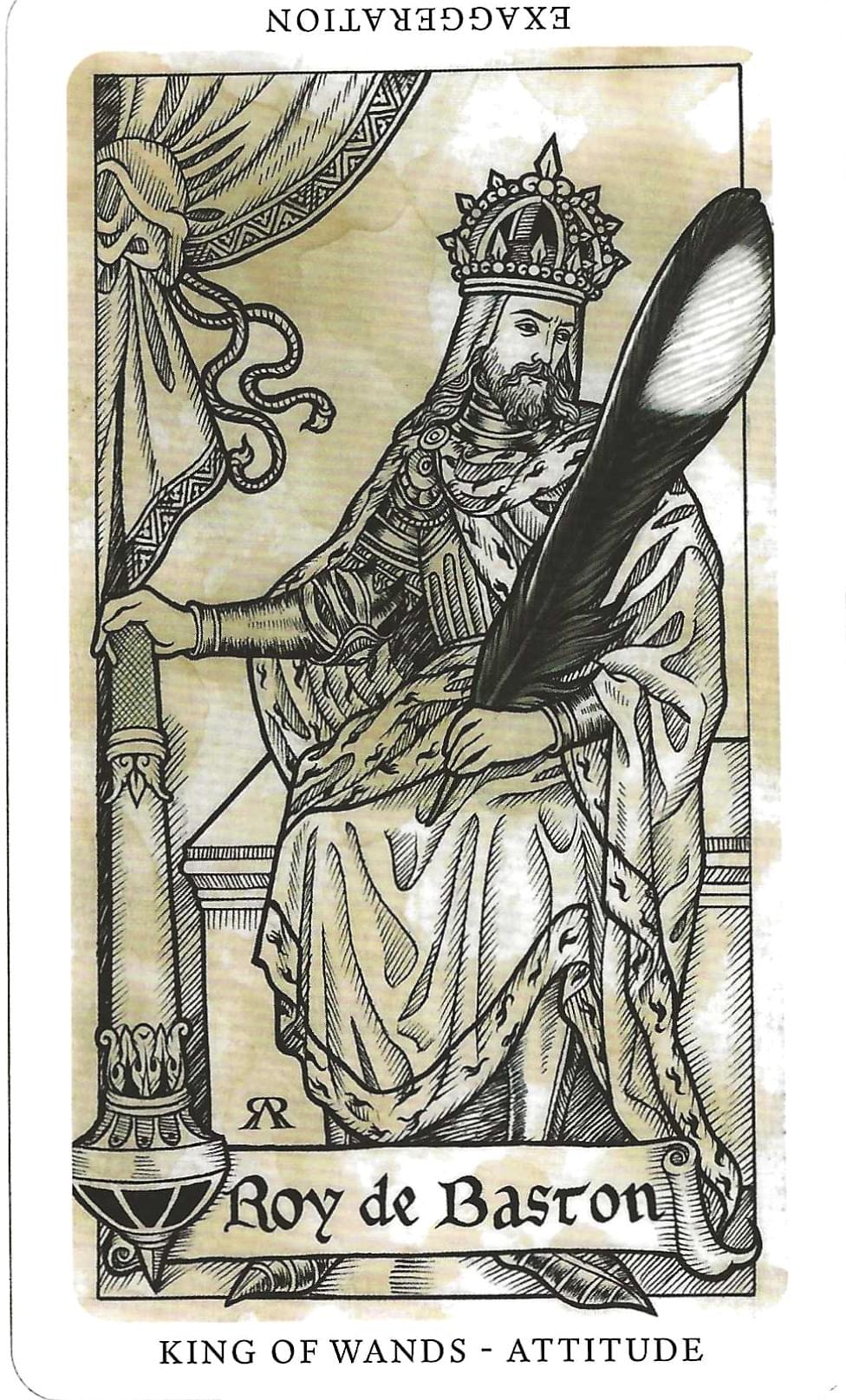
The Medieval Feathers Tarot-King of Wands

King of Wands: Thoth vs. Medieval Feathers
Thoth Tarot – King of Wands (Knight of Wands)
Form & Symbolism: In the Thoth system, the “King” is renamed Knight, and he is armored and mounted on a fiery charger. He hurls himself forward with a flaming wand — a weapon of solar lightning. His horse itself blazes with elemental fire, suggesting not a mere animal but a steed of divine flame.
Elemental Attribution: Fire of Fire — the most intense and eruptive expression of the Fire element. He is the spark of creation in its purest form, the Yod of YHVH made flesh and motion.
Hermetic Function: This Knight is the dynamic Will-to-Force. He does not sit in rulership — he acts. He is untamed flame, burning obstacles away, embodying inspiration, daring, and heroic command. His danger lies in consuming himself in his own blaze if not tempered by the Queen.
Astrological Scope: 20° Scorpio to 20° Sagittarius, covering the explosive transition from fixed water (Scorpio) into mutable fire (Sagittarius). His psyche fuses intensity, passion, and expansion — fire riding fire.
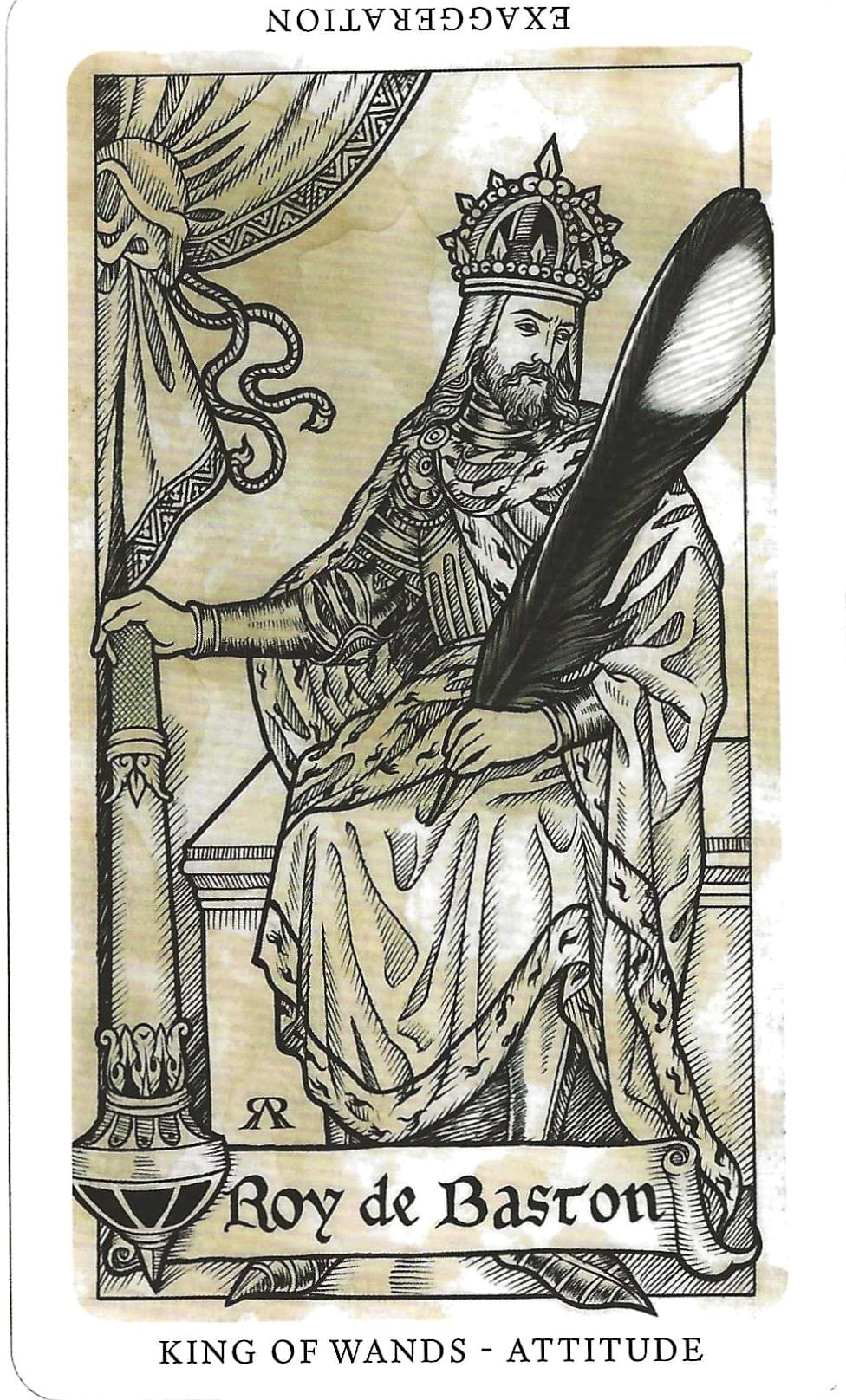
Medieval Feathers Tarot – King of Wands
Form & Symbolism: The Medieval Feathers deck returns the King to his enthroned authority. His staff is shown as a beacon of rulership, and his plume (the feather) suggests inspired vision and leadership. Unlike the Thoth Knight’s blazing charge, the Medieval King sits as sovereign — ruling over his domain with the warmth of fire and the stability of earthly kingship.
Elemental Attribution: Fire of Authority — fire contained and stabilized in the role of a monarch. Rather than unbridled eruption, this is fire cultivated into governance, charisma, and lasting influence.
Hermetic Function: This King represents Solar Fatherhood: the master of the will, whose inspiration is passed into the social and familial body. He rules, organizes, and protects, but does not necessarily move. He is the “settled flame” rather than the “wild fire.”
Personality Arc: He represents maturity in the realm of fire — a wise, visionary ruler, able to direct passions into fruitful action without losing control to volatility.
Hermetic Comparison Table
| Aspect | Thoth King (Knight of Wands) | Medieval Feathers King of Wands |
|---|---|---|
| Form | Armored knight on fiery steed, wand blazing in hand. | Enthroned monarch, plume and staff as symbols of rulership. |
| Element | Fire of Fire – eruptive, primal force. | Fire in rulership – cultivated, directed, stable flame. |
| Function | Dynamic Will-to-Force; initiator of movement and daring. | Solar authority; ruler who governs, inspires, and organizes. |
| Hermetic Tone | Yod of YHVH, divine impulse in motion. | Heh final of YHVH, consolidated flame expressed in rulership. |
| Danger/Shadow | Burns himself out; recklessness, self-consumption. | Dogmatism, rigidity, rule becoming tyranny. |
| Astrology | 20° Scorpio → 20° Sagittarius (volatile fire current). | General fire rulership; not as strictly zodiacal. |
Key Insight
The Thoth King/Knight is fire unleashed: the charging flame of creation, a dangerous yet divine outpouring of Will.
The Medieval Feathers King is fire enthroned: the warmth of a monarch’s rule, fire directed into governance and sustained authority.
Together, they reveal the two poles of solar rulership: the divine spark in motion (Thoth) and the sovereign flame stabilized in rulership (Medieval).

Tarot Core-Personality birth wheel

The Knight of Wands represents the fiery part of Fire---The Lightning flash--- and he rules from the 21st degree of Scorpio to the 20th degree of Sagittarius.
The astrological signs from the 21st degree of Scorpio to the 20th degree of Sagittarius cover a transition period between Scorpio and Sagittarius, incorporating qualities from both signs. Here are some characteristics typically associated with this span:
Intensity and Depth (Scorpio Influence): Scorpio is a sign known for its intensity, depth, and passion. Individuals born within this range may possess a profound emotional depth, with a strong desire to delve into the mysteries of life and explore the hidden aspects of themselves and others.
Resourcefulness and Determination (Scorpio Influence): Those influenced by Scorpio energy are often resourceful and determined. They have the tenacity to overcome obstacles and are not afraid to confront challenges head-on, utilizing their inner strength and resilience to achieve their goals.
Transformation and Renewal (Scorpio Influence): Scorpio is associated with transformation and rebirth. People born in this range may experience significant life changes or undergo profound inner transformations that lead to personal growth and renewal.
Idealism and Adventure (Sagittarius Influence): As the influence of Sagittarius begins to emerge, individuals in this range may exhibit a sense of idealism and a thirst for adventure. They are drawn to exploration, whether it be physical travel, intellectual pursuits, or spiritual quests, seeking to expand their horizons and broaden their perspective.
Optimism and Enthusiasm (Sagittarius Influence): Sagittarius is characterized by its optimism and enthusiasm for life. People born in this period may possess a naturally positive outlook, seeing the world as full of opportunities and possibilities waiting to be explored.
Philosophical and Broad-Minded (Sagittarius Influence): Sagittarius is associated with philosophy, higher learning, and a broad-minded approach to life. Individuals within this span may have a keen interest in exploring different belief systems, cultures, and ideologies, seeking to gain a deeper understanding of the world and their place within it.
Restless and Freedom-Loving (Sagittarius Influence): Sagittarius energy can be restless and freedom-loving, with a strong aversion to anything that feels restrictive or confining. People born in this range may crave independence and autonomy, valuing their freedom to explore and experience life on their own terms.
Overall, individuals born between the 21st degree of Scorpio and the 20th degree of Sagittarius are likely to embody a unique blend of Scorpio's intensity, depth, and determination, along with Sagittarius's idealism, adventurous spirit, and philosophical outlook on life.
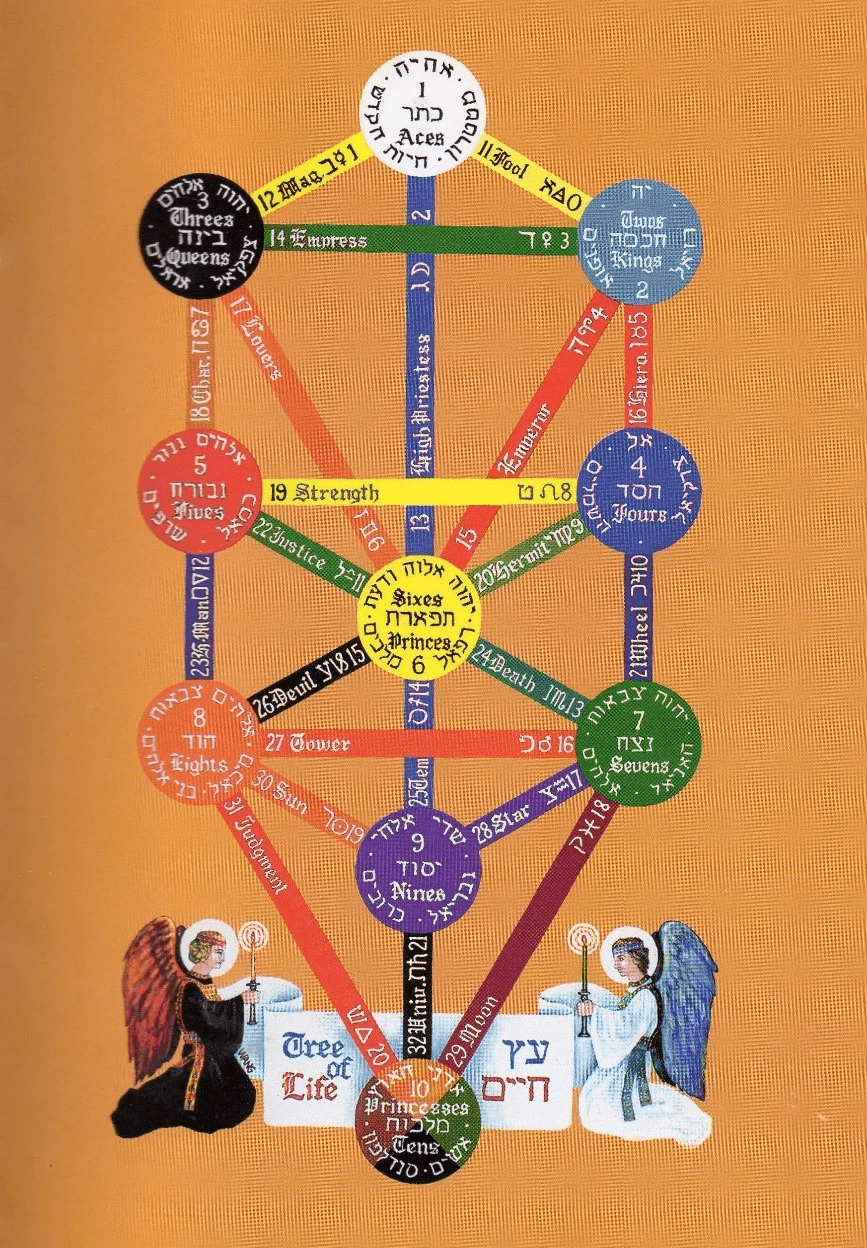
The Sephirothic Root of the King of Wands
The Knight/King of Wands draws his fiery essence from the 2nd Sephiroth — Chokmah (“Wisdom”) on the Tree of Life. Chokmah is the primal masculine polarity of energy, the Will-to-Force that bursts from Kether’s limitless light. It is the origin of motion, expansion, and dynamic creative fire.
This makes the Knight/King of Wands an inherently active archetype. He is the surge of lightning before form, the primordial spark that ignites the unfolding of worlds. In Hermetic terms, he embodies the Yod of YHVH — the generative Father-principle.

Valraven and Hel.
Mythic Parallels: Valraven and Prometheus
In Norse legend, this archetype finds voice in Valraven — the raven-king, said to have gifted the secret of magic to mankind. Like the Greek Prometheus, who gave humanity the fire of the gods, Valraven symbolizes fiery transmission: the dangerous gift of creative power.
Yet in myth Valraven also becomes the consort of Hel, Queen of the Underworld, which reveals the duality of this force: fire that both illuminates and destroys, fire that rules above but also descends below.
These myths emphasize the qualities of the King of Wands:
Generosity and magnanimity, sharing the fire of inspiration.
Fierceness and impetuosity, surging forth with daring action.
Pride and impulsiveness, often unpredictable in motion.
Swiftness, embodying the lightning strike of Chokmah.
The Shadow of the Archetype
If ill-defined, the Knight/King of Wands becomes destructive:
Evil-minded, cruel, and bigoted, consumed by his own fire.
Brutal and tyrannical, mistaking motion for mastery.
A wildfire without direction, consuming rather than illuminating.
In both the Thoth Tarot and the Medieval Feathers Tarot, the surrounding cards will reveal whether he appears in his higher form (Valraven the Giver of Fire) or in his shadow (Valraven the Despoiler).
Hermetic Lesson
The King of Wands is the embodied force of Chokmah’s lightning. He is fire before it takes form, the primal Yod that sets all things in motion. As Valraven and Prometheus remind us, this fiery gift is both salvation and peril. Properly directed, it awakens the human soul; uncontrolled, it burns the very hand that wields it.

The Lightning-Flash Nature of the Thoth Knight of Wands
In the Thoth system, the Knight of Wands (Medieval Feathers King) is described as “a lightning flash”. He embodies pure Chokmah-force — sudden, unrestrained, and unrepeatable. This means:
When he strikes, he strikes once with full intensity.
If that first effort fails, there is no reserve — the fire burns out, leaving only ash.
He is impulse incarnate — a surge of primal Will that does not pause to consider, but simply acts.
This trait can be a profound strength: when the goal is clear, the intent well-formed, and the issue already defined, the Knight of Wands succeeds by sheer force of directed will. Yet, because of his nature, he rarely waits to clarify these things. He is the strike of Zeus’s thunderbolt before the storm gathers.
Divinatory Advice
When this card appears in a spread, the querent is advised:
Be apprehensive, yet calm and resolute. Recognize the force at hand is immense, but transient.
Move with passionate energy but avoid being dragged into reckless, untimely action.
Trust your own ability — the lightning is within you — but temper it with awareness of timing.
Discernment is key: do not unleash the flame until you are sure of both target and intent.
Thus, the Knight/King of Wands is a double-edged archetype. On one side, he is the heroic surge of fire that wins by bold, decisive action. On the other, he is the wildfire that consumes itself before achieving its aim.
Hermetic Lesson
This card reminds us that Chokmah’s power is primal force — it must be tempered by Binah’s understanding if it is to endure. The Knight of Wands, without balance, is Prometheus unchained: a gift of fire that can save or destroy.

The Revolutionary Personality of the Knight/King of Wands
This is a revolutionary personality: startling in its passion, perilous in its charge, and impossible to ignore. In the Thoth Tarot, the Dark Horse leaping forward conveys this sense of untamed velocity — a sudden surge of force that breaks through all barriers.
Primal Sex-Force and the Flaming Wand
In his hand, the Knight of Wands bears the flaming Ace of Wands — the symbol of primal, generative fire. This is not only creative will but also the masculine fertility current of Kundalini:
Plasmic energy, rising like a lightning flash through the body’s channels.
The electric potency of the masculine principle, contrasted with the receptive magnetic current.
In Qabalistic terms, it is the descent of fire into the sphere of Malkuth (the Kingdom), where spirit incarnates into matter and where sex force is the bridge between Above and Below.
This card therefore speaks not only to creative daring, but also to the erotic root of life itself: the surge that animates, penetrates, and transforms.
Facing All Odds
When this archetype is well dignified, it has the courage to face all odds — the very definition of revolutionary force. It rushes in where others fear, carrying the daring of Valraven and Prometheus alike.
When ill dignified, that same intensity becomes peril: the charge becomes reckless, the sex-force becomes destructive, and the lightning current burns itself out.
Hermetic Lesson
The Knight/King of Wands embodies the truth that revolutionary fire is also sexual fire — the plasmic current that awakens creation in the human body as much as in history. To wield this force wisely is to ride the Dark Horse with awareness: passionate, daring, and unafraid, but guided by conscious Will rather than blind impulse.
Such King/Knight of Wands personalities known to us moderns are:

Indira Gandhi Born-Nov 19, 1917;

Robert Kennedy-November 20, 1925;

Mary Queen of Scots-Dec 08, 1542.

Robert Fulton, Nov 14, 1765

Frank Sinatra, Dec. 12, 1915.

The Attractive but Explosive Personality of the Knight/King of Wands
The Knight/King of Wands generates a personality that is undeniably powerful and attractive, regardless of gender. The fiery charisma of this archetype draws others in, like moths to flame — for here is passion embodied, daring in motion, and force in its most vital form.
Lady Frieda Harris’s Depiction
Lady Frieda Harris captures this explosive essence vividly in the Thoth Tarot: the Knight appears to ride not merely a horse, but a flaming rocket in the form of a black charger. The image conveys the volatile, unstable thrust of raw fire-force breaking from all containment.
The Risk of the Launch
This rocket-like personality comes with notable risks:
If the aim is off, or if the goal is misaligned, the launch collapses into failure as suddenly as it began.
If there is not enough emotional fuel, the fire sputters out, leaving the rider in a dramatic crash.
If there is too much fuel, the personality becomes unstable, erupting in an explosion of temper, recklessness, or overextension.
The Splendor of Success
Yet, when the energies align — when aim, intent, and emotional fuel are in harmony — this card signifies spectacular success. The Knight/King of Wands ignites ventures, inspires others, and carries the momentum of fire into achievements that astonish. Their very volatility becomes magnetism, their burning vitality an aura that others find irresistible.
Hermetic Lesson
The Knight/King of Wands is a cosmic launch sequence — a volatile alchemy of fire and will. It reminds us that passion must be aimed, fuel must be measured, and the fire must be harnessed. Properly directed, the energy is both creative and attractive, igniting others with inspiration. Unchecked, it burns itself out in the very act of self-destruction.

The Need for Balance: Fire and Water
History and Hermetic wisdom both affirm that a steady mind and willful emotional control are required to harness the explosive power of the Knight/King of Wands. This archetype carries the Yod force — the Hand of God — a power of divine lightning, creative yet perilous, capable of building or destroying in an instant.
The Role of the Feminine Magnetic Current
The only safe container for such fiery energy is the Magnetic Force of the Feminine Anima — either within the individual as the inner Water of the soul, or through relationship with another whose presence provides cooling balance.
The Water element symbolizes intuition, receptivity, and emotional containment.
Without this counterbalance, the fiery personality of the Knight/King of Wands is quick to anger, easily flaring into rages and violence.
With Water’s containment, the explosive fire becomes a directed flame, empowering creation and inspiring others without consuming itself.
Divinatory Application
When interpreting this card:
If the spread contains many Cup cards, or especially a Princess or Queen, the querent may rest assured that Water is present to moderate, cool, and sustain the fiery energy.
If no such balance appears, the warning is clear: passion must be tempered with emotional awareness, or else the fire burns uncontrolled.
Hermetic Lesson
The Knight/King of Wands teaches that every lightning flash requires a vessel. Fire alone is unstable; Fire within Water is creative. The Yod of divine fire must descend into the Heh of the Feminine to bring forth life, art, and transformation.
This is the alchemy of the Court: the volatile Knight finds his balance in the Queen. The masculine fire-force, without the magnetic embrace of the feminine, is a rocket without trajectory — brilliant in its blaze, but destined to self-destruct.

The Medieval Feathers Tarot-King of Wands
Medieval Feathers Tarot — King of Wands
Upright Meaning
The Medieval Feathers King of Wands counsels maturity, integrity, and presence. Here the fiery rulership of Wands is shown as responsible leadership:
You are called to stand tall as an adult, acting with maturity and wisdom.
By being authentically present and true to yourself, you naturally inspire others to rise to their own integrity.
This card suggests that your life is not just about personal choices, but about the example you set for those who look to you for guidance, stability, and vision.
This King is the archetype of fire in maturity — passion tempered into responsibility, charisma expressed as guidance.
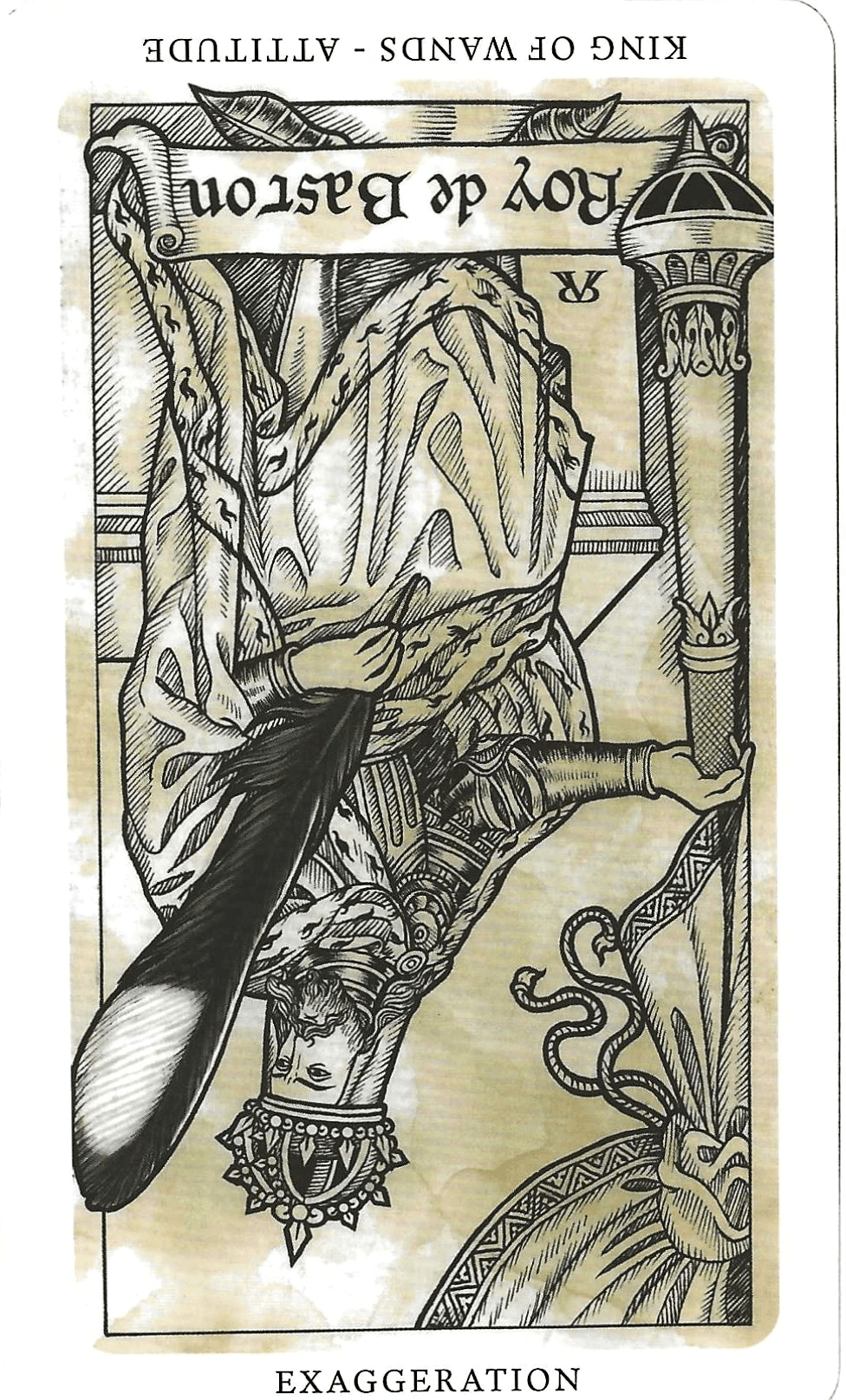
Reversed Meaning
When reversed, the King of Wands warns against immaturity and dramatization:
You may be blowing things out of proportion simply to gain attention.
The matter at hand does not require more drama — in fact, the issue can be solved easily with patience and tranquility.
No further help is required; what’s needed is for you to face the issue directly and fix it rather than diverting energy into theatrics or avoidance.
Here the reversal exposes the shadow side of rulership — when the fire of authority is misapplied as vanity or attention-seeking rather than true leadership.
Hermetic Note
Where the Thoth Knight of Wands emphasizes volatile eruption and revolutionary force, the Medieval Feathers King of Wands emphasizes measured fire: knowing when to blaze, and when to let the flame steady itself into warm guidance. Upright, he is maturity in action; reversed, he is a warning against childish dramatics.

Knight/King riding a Salamander.
Since the Knights/Kings all represent the 2nd Sephira, Chokmah, they represent both masculine wisdom and the ultimate male authority. Therefore, the Knight/King of Wands or Master also representsthe flame or spark that will ignite the 72 parts of our subconscious (72 names of God) that form inside our inner temple.
In medieval mystical and esoteric traditions, particularly those influenced by alchemical and Hermetic thought, salamanders were considered one of the four elemental spirits, each corresponding to one of the classical elements. Salamanders specifically represented fire.
Origins and Symbolism
The idea of salamanders as fiery elementals likely arose from the real-life salamander's behavior and habitat. Salamanders often emerged from logs or wood when exposed to heat or flames, as they dwell in damp environments. This phenomenon led to the mistaken belief that they were born of or lived in fire, giving them an association with the element.
Role in Esoteric Thought
In the Western Hermetic tradition, these creatures were classified among the elemental beings:
- Gnomes: Earth
- Undines: Water
- Sylphs: Air
- Salamanders: Fire
Salamanders symbolized the transformative, purifying, and consuming power of fire. They were seen as the fiery spirit within flames and were thought to embody the creative and destructive aspects of fire, reflecting its dual nature.
Paracelsus and the Salamanders
The concept of salamanders as fiery elementals was popularized by the 16th-century alchemist and mystic Paracelsus. In his work Liber de Nymphis, Sylphis, Pygmaeis et Salamandris et de caeteris spiritibus, Paracelsus elaborates on the elemental spirits, describing salamanders as the spirits of fire who inhabit flames and volcanic regions. He portrayed them as both literal and metaphorical representations of fiery energy and inspiration.
Symbolism in Mysticism and Magic
Salamanders are associated with:
- Passion and creativity: Fire represents energy, enthusiasm, and the spark of life.
- Transformation: Fire purifies and transforms substances in alchemy, symbolizing spiritual renewal and enlightenment.
- Destruction and renewal: They remind practitioners of the cyclical nature of destruction and creation.
In medieval and Renaissance art, salamanders were often depicted surrounded by flames, emphasizing their fireproof and fiery nature.
Modern Interpretations
In contemporary esoteric practices, salamanders are sometimes invoked or meditated upon to connect with the fiery aspects of the self, such as willpower, courage, and passion. They also serve as symbols for the fire element in ritual magic, particularly in traditions influenced by Hermetic Qabalah.
Their enduring presence in mystical lore highlights the rich tapestry of symbolic associations humanity has woven around the natural world.
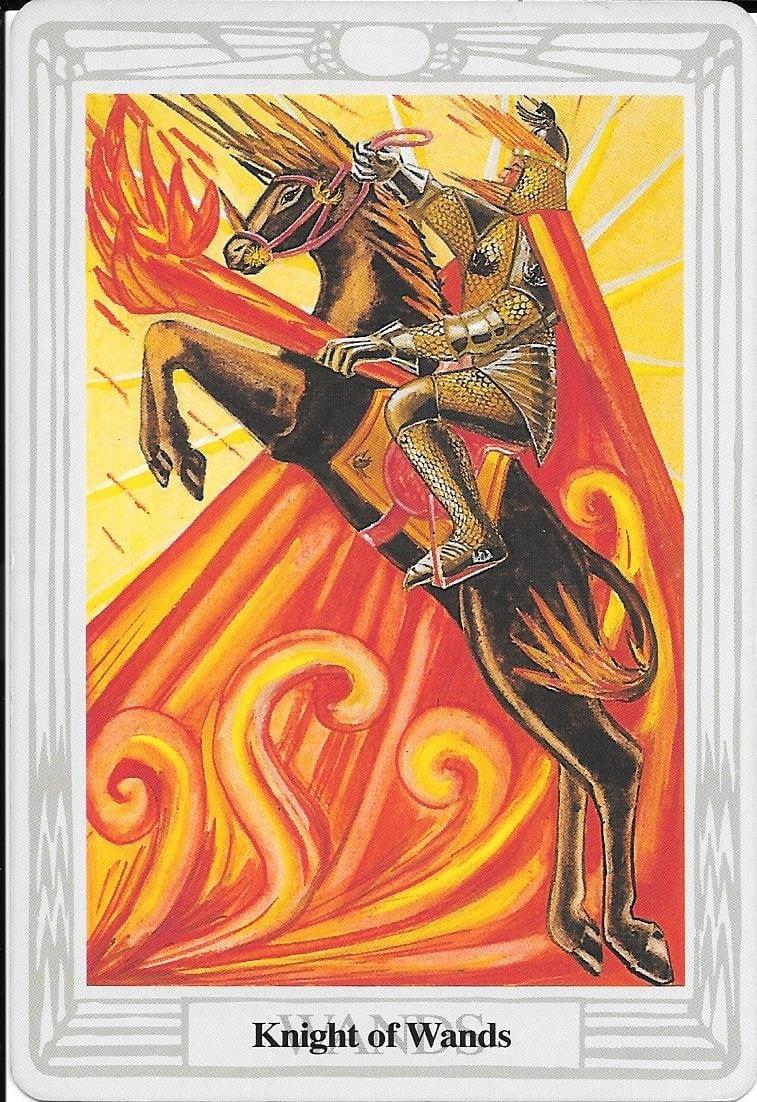
A Note on Reversals in the Thoth Tarot
Unlike many other decks, the Thoth Tarot does not employ reversed meanings. In Crowley’s system, no card is intrinsically negative. Instead, each card is considered in the context of the surrounding spread. If the neighboring cards are ill-defined, they can shade or distort the expression of the card in question.
This principle reflects the Hermetic essence of the Thoth deck:
All cards are forms of Gnosis. Knowledge itself is neutral — neither good nor bad.
What appears “negative” is simply knowledge in the form of error, which is still treasure, for error is the first step toward correction.
Crowley often pointed out that 50% of all knowledge begins as mistake and ends as correction. Thus, to know what not to do is as valuable as knowing what to do. Both are riches in the treasury of Wisdom.
Therefore, in the Thoth system, even the volatile and explosive Knight of Wands is never simply a “bad card.” He is always a revelation of force, and the question is whether that force is being channeled with wisdom or distorted by imbalance.

King of Wands: Thoth vs. Medieval Feathers
| Aspect | Thoth Tarot – Knight of Wands | Medieval Feathers Tarot – King of Wands |
|---|---|---|
| Form & Imagery | Armored Knight charging on a black, fiery steed — more rocket than horse. Flaming wand in hand, surrounded by flame. Lady Frieda Harris paints him as a living lightning-flash. | Enthroned King with plume and wand/staff of rulership. His feather signifies inspired vision and leadership; seated authority rather than charging motion. |
| Elemental Force | Fire of Fire — eruptive, primal lightning-force, Yod of YHVH. Pure Will-to-Force, unrestrained. | Fire stabilized in rulership — charisma and warmth matured into governance, guidance, and responsible authority. |
| Sephirothic Root | Chokmah (2nd Sephirah) — primal masculine polarity, dynamic expansion, Will-to-Force. | Expresses fire through Malkuth as mature rulership: fire that has settled into form, guiding community and self. |
| Mythic Resonance | Valraven, Prometheus: fiery gift-givers who bring magic or fire to humanity. Archetype of the revolutionary, dangerous, and inspired. | Archetype of the wise ruler and exemplar. Fire tempered by maturity; the King as role model who leads by presence and example. |
| Erotic / Primal Force | Flaming Ace of Wands = phallic plasmic current of Kundalini. Masculine electric force surging into Malkuth. Tremendous sex-force, both creative and perilous. | Sexual force sublimated into responsibility and charisma — fertility expressed in protection, guidance, and legacy rather than raw eruption. |
| Personality Traits | Charismatic, passionate, daring, volatile. Lightning-flash: if first effort fails, no reserve. Attractive to others, but unstable if not balanced by Water. Can face all odds. | Mature, authentic, present. Inspires others through example. Upright = integrity, maturity, leadership. Reversed = dramatization, immaturity, attention-seeking. |
| Dangers / Shadow | Ill-defined when surrounded by poorly dignified cards: cruelty, bigotry, brutality, rage, violence. Risk of burning out or exploding emotionally. No reversals in Thoth — error itself is treasure, knowledge gained through correction. | Reversed meaning: blowing things out of proportion, seeking attention, turning away from solvable issues. Advice: return to patience, fix matters calmly. |
| Divinatory Guidance | Be apprehensive yet calm and resolute. Channel passionate energy with awareness of timing. Balance Fire with Water (Queens, Princesses, or Cup cards nearby show containment). All cards are Gnosis — no true negativity. | Stand up for yourself with maturity. Be true to yourself and others will follow. When reversed, avoid drama; be patient, tranquil, and directly solve the issue. |
| Overall Hermetic Tone | Dynamic force — revolutionary, startling, perilous, and inspiring. Fire in eruption. The Hand of God as lightning. | Mature rulership — steady, responsible, inspiring. Fire enthroned. The King as model of authentic leadership. |
Key Insight
The Thoth Knight of Wands embodies fire as revolution — explosive, primal, and magnetic, demanding containment through the feminine Water principle.
The Medieval Feathers King of Wands embodies fire as rulership — matured into guidance, example, and measured action, with upright/reversed meanings clarifying its shadow.


Above all things, Know thyself!
WHEN THE KNIGHT OF WANDS or KING OF WANDS CARD, IS THROWN DURING A DIVINATION: It implies:
- Humane ideals.
- The Moral qualities of Activity, fierceness, impetuosity, impulsiveness, and swiftness in unpredictable actions.
- A spiritual evolutionary, who is shedding old perceptions for new spiritual insight.
- Much movement and energy while experiencing a new conviction.
- Releasing and letting go of an old identity or self-image.
- An entrepreneur who is achievement oriented, creative, and self-expressive.
- Positive male power personality that has the energy to handle long term goals, and handle extremely complex situations.
- Full of wit and charm, having a warm good nature, a sense of humor and love of fun.
- A calm and stuffy person.
- A rooted quality that gives strength.
- Meeting interesting people.
If ill defined by the surrounding cards, it implies:
- Despotic nature.
- Egotism.
- Intolerance.
- Intellectual Snobbishness.
- Confusion and the resulting weakened will it creates.
Thank you for your interest, comments, and supportive donations. Your generosity blesses you. May you live long and prosper.
🔥 Thoth Master Class
Western Hermetic Qabalah & Tarot
Private One-on-One Esoteric Training with Magus Eli
This Isn’t a Tarot Class. This Is a Soul Activation.
Step into the current of Living Light.
The Thoth Master Class is a one-on-one initiatory experience that fuses Hermetic wisdom, Qabalistic structure, and the archetypal genius of the Thoth Tarot — all personally guided by Magus Eli, master teacher and Solar Self awakener.
These aren’t generic lectures. They are ritual-grade, soul-specific transmissions designed to unlock your inner Temple, align your psychic architecture to the Tree of Life, and awaken your resonance with the living language of Tarot.
🌞 What Makes This Class a True Initiation?
🎓 Private Apprenticeship: Just you and the Magus in a deep 2-hour Google Meet session, entirely focused on your development.
🔄 Flexible Rhythm: Weekly, biweekly, or monthly — you set the pace. (12 sessions recommended for full arc of mastery.)
📹 Recorded Sessions: Each class is recorded so you can revisit the teachings and track your spiritual evolution.
🌿 Living Hermeticism: You won’t just learn about Qabalah — you’ll live it, feel it, and integrate it into your energetic field.
🃏 Practice Meets Power: You’ll lay spreads, decode symbols, and channel Tarot through your own voice, with real-time feedback and co-interpretation.
🜂 What You'll Learn (and Embody):
The entire architecture of the Thoth Tarot: Major Arcana, Minor Arcana, and Court Cards through a Hermetic lens
The Western Hermetic Qabalah: 10 Sephiroth, 22 Paths, and the Four Qabalistic Worlds
How to use Tarot as a portal to meditative pathworking and astral temple building
Rituals, spreads, and practices that bring gnosis, guidance, and transformation
How to build your personal mystical system, rooted in self-authority and Divine resonance
📚 What You’ll Need to Begin:
The Qabalistic Tarot: A Textbook of Mystical Philosophy by Robert Wang
A Thoth Tarot deck (Crowley-Harris edition preferred)
A Book of Shadows or personal journal
A desire to know thyself through the Solar Flame
🌟 Is This Class for You?
Yes — if you are:
A beginner with a soul-call to the Thoth deck, but no formal training
An experienced reader seeking depth, ritual, and Hermetic context
A mystic ready to reclaim your path through archetype, symbol, and gnosis
Anyone craving one-on-one spiritual mentorship in the Western Esoteric Tradition
✉️ How to Begin Your Journey
Email eli@elitarotstrickingly.com
to schedule your personal resonance mapping session and secure your first class.
💠 Investment in the Self — Not in Gold
At The Tarot of Eli, money is never the gatekeeper of gnosis.
These teachings are offered on a sliding scale, because every soul ready to walk the Path deserves a guide. You are not buying a class — you are answering the call of your Soul.
If you feel the fire of this journey within, reach out. Let’s find a way that works for your means. No sincere aspirant will be turned away for lack of coin.
🕊️ The true currency of this Master Class is your will to become who you truly are.
3 Western Hermetic Tarot and Magick websites helping people become more magic and less tragic since 2010.
The Home page, Tarot Store-Master Tarot Classes page and nontraditional tarot card comparisons (Thoth etc.)
Traditional Tarot Card Comparisons blog (Rider-Waite-Smith and B.O.T.A etc.)
Western Hermetic magick invocation and ritual website and blogs.
